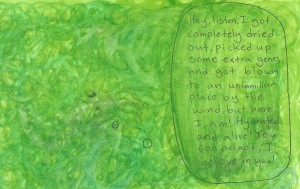
This animation was created to show the way rotifers move, as well as display the struggles of drawing a live organism.
Rotifers are zooplankton that inhabit a variety freshwater habitats, both stationary and flowing, as well as many other things such as moist soil, mosses, gutters, sewers, and many more. They have a small brain and up to five eyes, and their name comes from the Latin word for ‘wheel-bearer’ because of the cilia around the crown-like mouth of the organism. They use these cilia both to pull themselves through the water and move food into their mouth, as they also have a complete digestive system with a mouth and anus. They eat things like detritus, and aid in nutrient recycling, making them useful to keep fish tanks clear. On the other side of things, they are eaten by creatures such as copepods, fish, jellyfish, and starfish.
While some rotifers reproduce sexually, bdelloidea reproduce completely asexually. They’re all females, and expand the population by producing eggs that don’t need to be fertilized. Typically, this makes it difficult to be evolutionarily successful, since all offspring simply have an exact copy of that parent’s genes, making the only genetic variation come from mutations, or accidental alteration of the genome. Unfortunately, more often than not a mutation is the opposite of helpful to the species. This makes it nearly impossible for the organism to evolve and adapt to changes in it’s environment. However, scientists noted that bdelloidea seem to occasionally gain a new gene. They seem to be somehow taking genes from the environment and incorporating them into their own genome. I find this fascinating, and one moral idea I could see being taken from this is that there’s always a solution. It might not be obvious but you should never give up, because there will always be something that you can do, just like the bdelloidea taking genes from the environment.
Although rotifers typically only live in freshwater environments, bdelloidea tend to live in brackish and even marine environments. They’re extremely resilient, even being able to survive radiation and drying out. In fact, drying out can help them to survive. They do it through a process called cryptobiosis, and can be blown around in the wind, or carried to other locations, and revive once they’re re-submerged in water. In fact, there’s evidence to suggest that this is the state in which gene transfers happen between the rotifer and other things such as bacteria, as mentioned in the paragraph above. This feature teaches us a lot about perseverance and adaptability. I would say they have an amazing ability to ‘just go with the flow’, a trait that I think we should all aim to have, although there are some things that we should stand our ground on. In general, however, these amazing tiny creatures have a lot to teach us about the world.
References
1. Mark Welch D. and Meselson M. 2000. “Evidence for the evolution of bdelloid rotifers without sexual reproduction or genetic exchange.”
2. Bell, G. 1982. “The Masterpiece of Nature: The Evolution and Genetics of Sexuality.”
3. Gladyshev, E. A., Meselson, M. and Arkhipova, I. R. 2008. “Massive horizontal gene transfer in bdelloid rotifers.”
4. Bdelloid Rotifers Going About Rotifer Business. (2011, May 7). Retrieved November 19, 2015, from https://www.youtube.com/watch?v=hed0cCfCcYQ
5. Baqai, A., Guruswamy, V., Liu, J., Rizki, G., & Speer, B. (2000, May 1). Introduction to the Rotifera. Retrieved November 19, 2015, from http://www.ucmp.berkeley.edu/phyla/rotifera/rotifera.html
6. Dioni, W. (2008, September 1). Micscape Microscopy and Microscope Magazine. Retrieved November 19, 2015, from http://www.microscopy-uk.org.uk/mag/indexmag.html?http://www.microscopy-uk.org.uk/mag/artsep08/wd-rotifer.html



